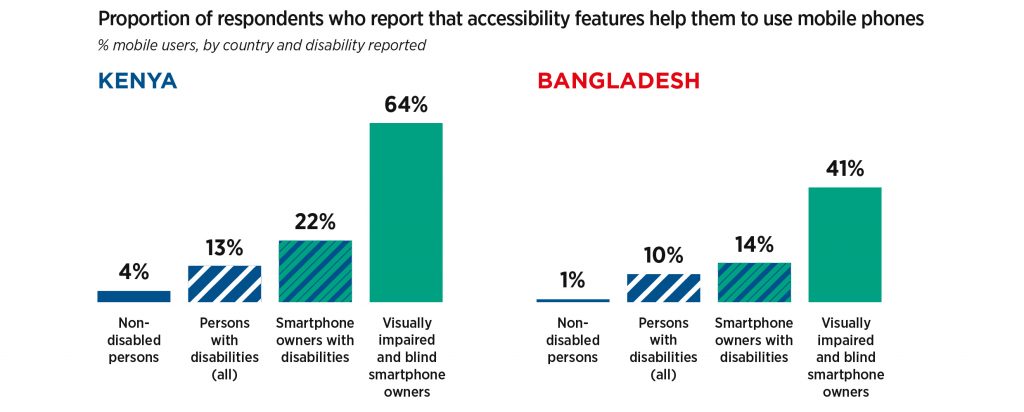On 20 November, the GSMA Assistive Tech team was invited to present their research on the mobile disability gap in Kenya and in Bangladesh at TechShare Pro 2019. Organised by AbilityNet and Google Accessibility, this event brings together different experts in accessibility and inclusive design of digital products and services. You can watch the presentation on Youtube. In this blog, we highlight some of the findings on the use of accessibility features by persons with disabilities in Kenya and Bangladesh, and the relevance of digital skills as a way to close the mobile disability gap.
The majority of mobile users with disabilities do not have access to accessibility features
Our previous blog explored the level of mobile ownership and type of phone owned by persons with disabilities in Kenya and Bangladesh. Based on our research, persons with disabilities are less likely to own a mobile phone than non-disabled persons, indicating a mobile disability gap of 12 per cent in Kenya and 13 per cent in Bangladesh.
When thinking about the digital inclusion of persons with disabilities, the type of phone owned or accessed is of critical importance. Although a basic phone can provide several functions for some persons with disabilities, the suite of accessibility features that smartphones have facilitate the use of a phone, as well as access to information and digital products. However, over 70 per cent of mobile users with disabilities own a basic or a feature phone – limiting the opportunities for mobile to act as an assistive technology (AT). As regional markets, such as the African market, are still dominated by feature phones, more needs to be done to embed accessibility features in these internet-enabled phones.
The use of accessibility features for smartphone owners with disabilities is low
Assistive technologies (ATs) are designed to improve the functional capabilities of people with disabilities and enable them to live productive and independent lives. Most smartphones have a variety of built-in accessibility features or allow third-party applications. For example, a text-to-speech feature may read text out loud for people with visual impairments and dictation features let you fully control your phone using only your voice.
However, the use of accessibility features by mobile users with disabilities is still quite limited. In our research, we found that only around 10 per cent of persons with disabilities use accessibility features. This limited use is, in part, due to the type of mobile phone owned, unawareness that these features exist, and the lack of digital skills to use them. Even smartphone owners with disabilities have a limited use of accessibility features. Only 22 per cent of them in Kenya and 14 per cent in Bangladesh reported using accessibility features. Finally, due to the visual nature of touchscreen interface and the internet, mobile users with visual impairment or those who are blind that own a smartphone, greatly benefit from accessibility features and, thus, many reported using accessibility features to be able to operate a mobile.
How mobile accessibility features impacts the lives of PWDs?
During our research in Kenya we spoke to John about the enabling role of mobile in his life. Watch his video to learn how he uses TalkBack – a Google screen reader included in Android devices enabling him to receive spoken feedback and navigate features and services eyes-free – it allows John to independently use M-Pesa services, navigate to places with Google Maps, communicate with friends, colleagues and lecturers, and to access educational material on YouTube.
Accessibility features are necessary for mobile to fully become an assistive technology and facilitate connection and participation of persons with disabilities in everyday activities that were not previously possible.
Although many accessibility features – and notably the most effective ones – are only available on higher end smartphones, making them unaffordable to most, our in-country research highlights how those with the most sophisticated devices get the most value out of their phone. Accessibility features should not be a service/product development afterthought, and efforts from handset makers to embed built in accessibility across device range would unlock digital inclusion and a better mobile experience for persons with disabilities.





